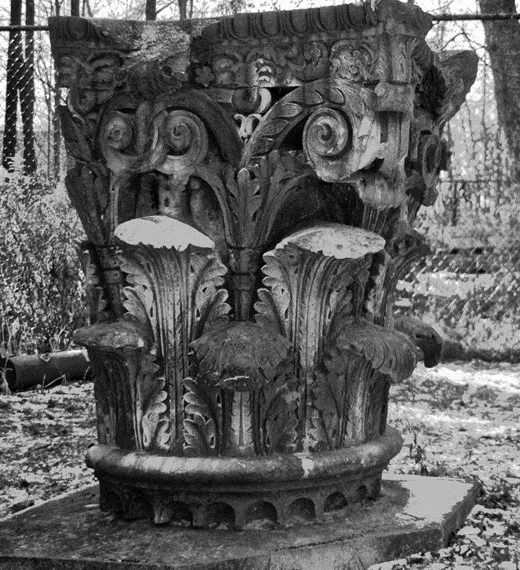Lost and Found: Rediscovering Fragments of Old Toronto
May 18, 2018–May 2019
Campbell House Museum, 160 Queen Street West
Leora Bebko, Hannah Hadfield, Tanya McCullough
Goal/Curatorial Statement:
Lost and Found showcases a group of architectural fragments that have been salvaged from iconic downtown buildings demolished over fifty years ago. Exhibited on the grounds of the Campbell House Museum against the backdrop of the modern cityscape, these remnants call to mind a Toronto that no longer exists. The exhibition reflects on the people and forces that shaped Toronto’s landscape in the past, and, ultimately, asks the visitor to consider the future of heritage conservation in the city.
Intended Audience:
Lost and Found was designed for a wide audience. Intended for tourists and local residents alike, the exhibition will appeal to a cross-section of people: those interested in history, heritage conservation, art, architectural design, and those just curious to see pieces of Toronto’s past up close.
Venue:
The stone fragments will be arrayed in six clusters around the Campbell House museum grounds. Built in 1822, the house itself was salvaged and moved to its present location in 1972 to prevent its demolition. This makes Campbell House the perfect venue for engendering a discussion about conserving fragments of the past.
Sponsors:
The exhibition would not have been possible without assistance from many sponsors. We would like to thank the Campbell House Museum, Queen West BIA, the Architectural Conservancy of Ontario, Toronto chapter, and the University of Toronto Faculty of Information for their financial support, as well as the City of Toronto for lending us the stones for the exhibition. We are also grateful to ERA Architects, J.D. Strachan Construction Ltd., Historic Restoration Inc., Blackwell Structural Engineers for literally and figuratively doing much of the heavy lifting in this project by moving, mounting, and installing the stones for in kind payment.
Basic Timeline:
Planning for Lost and Found began in September 2017. Solidifying the exhibition thesis took four months. At the end of January 2018, we completed our research and began writing our panel texts. By the end of March, we sent our finalized text to the graphic designer. The stones will be moved and installed at the museum in April, and the exhibition panels will be installed in time for the opening reception and invited panel discussion on May 17th, 2018.
Types of Presentation:
Lost and Found consists of three main components: the outdoor installation of architectural fragments from the City of Toronto’s historical collection—presently residing in storage at the Guild Park and Garden––outdoor panels contextualizing the architectural pieces, and a public panel featuring invited guests from the City of Toronto, a community group, and an heritage architecture firm discussing cultural heritage management in Toronto.
These fragments once graced the façades of some of Toronto’s best-known buildings––the headquarters of the Bank of Toronto, Ontario Bank, and The Bank of Montreal, and the old Imperial Oil and Toronto Star buildings. The sixth stone commemorates Toronto’s first jail and courthouse buildings. The six groupings of architectural fragments will be positioned throughout the grounds to maximize visual impact and to provide meaningful sight lines against the city backdrop.
Marketing Programming:
The exhibition will be publicized on Facebook, Instagram, and Twitter and will benefit from the Campbell House Museum marketing presence. A poster at the corner of Queen and University in front of Campbell House––as well as the stones’ visibility from the street––will likely attract a large number of pedestrians. Since there is limited space at the public panel discussion event, we will solicit RSVP responses through Eventbrite. Finally, we will send notifications of our exhibition to online newspaper outlets such as BlogTO and NOW Magazine for free promotion.
Outcomes
Lost and Found is a pilot project for the City of Toronto. The City is looking for ways to meaningfully make use of the artifacts in their historical collections. If the exhibit is successful, the stones from the exhibition may become a permanent fixture in the city.
The exhibition is expected to attract a large number of visitors. It is estimated that nearly one million pedestrians will pass by Campbell House in the year that the fragments will be on display. If only five percent of persons stop to see the exhibition and reflect on Toronto’s relationship to its cultural heritage, it will be a success.
Acknowledgements
The curatorial team behind Lost and Found would like to thank all of our sponsors, as well as the following individuals in particular for their time and support: Liz Driver, Director of Campbell House Museum; Jo Ann Pynn, Alexandra Avdichuk, and Barbara MacLean, City of Toronto representatives; Max Allen and Ralph Daley from the Grange Community Association; Mikael Sydor from ERA Architects; Cathy Nasmith, President of Toronto chapter of the Architectural Conservancy of Ontario; Matthew Brower, the Director of the Museum Studies Program; Edwin Rowse, Founder of ERA Architects; and Carl Shura for kindly designing our panels.
History exhibit
architecture, conservation, Guild Inn, Heritage, history, masonry, preservation, salvage, stone fragments, Toronto, urbanism
